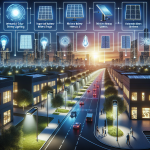The Environmental Footprint of Commercial Solar Street Lighting
-
Table of Contents
The environmental footprint of commercial solar street lighting is a critical consideration in the transition towards sustainable urban infrastructure. As cities worldwide strive to reduce their carbon emissions and enhance energy efficiency, solar street lighting emerges as a viable solution that harnesses renewable energy to illuminate public spaces. Unlike traditional street lighting systems that rely on fossil fuels, solar street lights utilize photovoltaic panels to capture sunlight and convert it into electricity, significantly reducing greenhouse gas emissions. Additionally, these systems often incorporate energy-efficient LED technology, further minimizing energy consumption. The production, installation, and maintenance of solar street lighting systems also have environmental implications, including the use of materials and the lifecycle of the components. However, the long-term benefits, such as reduced reliance on non-renewable energy sources and decreased operational costs, contribute positively to their overall environmental footprint. As technology advances and economies of scale are achieved, the environmental impact of solar street lighting is expected to diminish, making it an increasingly attractive option for sustainable urban development.
Understanding The Environmental Benefits Of Commercial Solar Street Lighting
Commercial solar street lighting has emerged as a sustainable alternative to traditional street lighting systems, offering a myriad of environmental benefits that contribute to a greener future. As urban areas continue to expand and the demand for energy-efficient solutions grows, understanding the environmental footprint of these systems becomes increasingly important. Solar street lighting harnesses the power of the sun, a renewable energy source, to illuminate streets, thereby reducing reliance on fossil fuels and decreasing greenhouse gas emissions. This transition to solar energy is a crucial step in mitigating climate change and promoting environmental sustainability.
One of the most significant environmental benefits of commercial solar street lighting is its ability to reduce carbon emissions. Traditional street lighting systems are typically powered by electricity generated from fossil fuels, which release carbon dioxide and other harmful pollutants into the atmosphere. In contrast, solar street lights operate independently of the grid, utilizing photovoltaic panels to convert sunlight into electricity. This process is entirely clean and does not produce any emissions, making solar street lighting a carbon-neutral solution. By replacing conventional street lights with solar-powered alternatives, cities can significantly lower their carbon footprint and contribute to global efforts to combat climate change.
Moreover, solar street lighting systems are designed to be energy-efficient, further enhancing their environmental benefits. These systems often incorporate LED technology, which consumes less energy and has a longer lifespan compared to traditional lighting options. LEDs are known for their high luminous efficacy, meaning they provide more light per unit of energy consumed. This efficiency not only reduces the overall energy demand but also minimizes the need for frequent replacements, thereby decreasing waste and the environmental impact associated with manufacturing and disposing of lighting components.
In addition to reducing emissions and energy consumption, commercial solar street lighting also promotes environmental conservation by minimizing land disturbance. Traditional street lighting infrastructure requires extensive cabling and trenching, which can disrupt local ecosystems and lead to habitat destruction. Solar street lights, on the other hand, are typically installed with minimal ground disturbance, as they do not require connection to the electrical grid. This feature makes them particularly suitable for environmentally sensitive areas, where preserving natural landscapes is a priority.
Furthermore, the use of solar street lighting can lead to significant reductions in light pollution, which is an often-overlooked environmental issue. Light pollution not only obscures the night sky but also disrupts ecosystems and affects wildlife behavior. Solar street lights are equipped with advanced control systems that allow for precise management of light output, ensuring that illumination is provided only when and where it is needed. This targeted approach reduces unnecessary light spillage and helps maintain the natural balance of nocturnal environments.
In conclusion, the environmental benefits of commercial solar street lighting are manifold, encompassing reductions in carbon emissions, energy consumption, land disturbance, and light pollution. As cities and communities strive to become more sustainable, the adoption of solar street lighting represents a practical and effective measure to lessen their environmental impact. By embracing this technology, urban planners and policymakers can contribute to a cleaner, more sustainable future, while also reaping the economic and social benefits that come with reduced energy costs and improved public safety. As the world continues to grapple with the challenges of climate change and environmental degradation, the role of solar street lighting in promoting sustainability cannot be overstated.
Reducing Carbon Emissions With Solar-Powered Street Lights

The environmental footprint of commercial solar street lighting is a topic of growing importance as cities and municipalities worldwide seek sustainable solutions to reduce carbon emissions. Solar-powered street lights offer a promising alternative to traditional lighting systems, which rely heavily on fossil fuels and contribute significantly to greenhouse gas emissions. By harnessing the power of the sun, solar street lights provide an eco-friendly option that aligns with global efforts to combat climate change.
To begin with, the primary advantage of solar-powered street lights is their ability to operate independently of the electrical grid. This independence is achieved through the integration of photovoltaic panels, which capture sunlight and convert it into electricity. The energy is then stored in batteries, allowing the lights to function even during cloudy days or at night. This self-sufficiency not only reduces reliance on non-renewable energy sources but also minimizes the carbon footprint associated with electricity generation. Consequently, the adoption of solar street lighting can lead to a substantial decrease in carbon emissions, contributing to cleaner air and a healthier environment.
Moreover, the installation of solar street lights can result in significant cost savings over time. While the initial investment may be higher compared to conventional lighting systems, the long-term benefits are considerable. Solar street lights eliminate the need for extensive wiring and trenching, which are both costly and environmentally disruptive. Additionally, they require minimal maintenance, as they are designed to withstand harsh weather conditions and have a longer lifespan than traditional street lights. These factors contribute to a reduction in operational costs, making solar street lighting a financially viable option for municipalities aiming to reduce their carbon footprint.
In addition to their environmental and economic benefits, solar-powered street lights also enhance public safety and security. Well-lit streets deter criminal activities and reduce the risk of accidents, creating safer communities. The reliability of solar street lights ensures consistent illumination, even during power outages, which are becoming increasingly common due to extreme weather events linked to climate change. By providing a dependable source of light, solar street lights contribute to the resilience of urban infrastructure, further supporting sustainable development goals.
Furthermore, the implementation of solar street lighting can serve as a catalyst for broader environmental awareness and action. As communities witness the tangible benefits of renewable energy, they may be more inclined to adopt other sustainable practices, such as energy-efficient appliances and electric vehicles. This shift in mindset can lead to a ripple effect, encouraging individuals and businesses to prioritize sustainability in their daily operations and decision-making processes.
In conclusion, the environmental footprint of commercial solar street lighting is significantly smaller than that of traditional lighting systems. By reducing carbon emissions, lowering operational costs, enhancing public safety, and promoting environmental consciousness, solar-powered street lights represent a crucial step towards a more sustainable future. As cities continue to grow and the demand for energy increases, the transition to renewable energy sources like solar power becomes imperative. Embracing solar street lighting not only addresses immediate environmental concerns but also paves the way for a cleaner, greener planet for future generations.
The Role Of Solar Street Lighting In Sustainable Urban Development
The environmental footprint of commercial solar street lighting is a critical consideration in the broader context of sustainable urban development. As cities around the world grapple with the dual challenges of rapid urbanization and climate change, the adoption of renewable energy solutions has become increasingly imperative. Solar street lighting, in particular, offers a promising avenue for reducing the environmental impact of urban infrastructure while enhancing the quality of life for city dwellers.
To begin with, solar street lighting systems harness energy from the sun, a renewable and inexhaustible resource, thereby significantly reducing reliance on fossil fuels. This shift is crucial in mitigating greenhouse gas emissions, which are a primary driver of global warming. By replacing conventional street lighting, which typically relies on electricity generated from coal or natural gas, with solar-powered alternatives, cities can substantially decrease their carbon footprint. This transition not only contributes to cleaner air and a healthier environment but also aligns with global efforts to combat climate change.
Moreover, the installation of solar street lighting systems can lead to considerable energy savings. Traditional street lights consume a significant amount of electricity, often accounting for a large portion of a city’s energy expenditure. In contrast, solar street lights operate independently of the grid, drawing power directly from solar panels. This independence not only reduces energy costs but also enhances energy security by minimizing vulnerability to power outages and fluctuations in energy prices. Consequently, cities can allocate resources more efficiently, investing savings in other critical areas of urban development.
In addition to environmental and economic benefits, solar street lighting plays a pivotal role in promoting social sustainability. Well-lit streets are essential for ensuring public safety and enhancing the livability of urban areas. Solar street lights can be deployed in remote or underserved regions where access to the electrical grid is limited or non-existent. By providing reliable and sustainable lighting solutions, these systems help bridge the infrastructure gap, fostering inclusivity and equity in urban development.
Furthermore, the adoption of solar street lighting can stimulate local economies by creating jobs in the renewable energy sector. The manufacturing, installation, and maintenance of solar lighting systems require skilled labor, offering employment opportunities and contributing to economic growth. This aspect is particularly significant in developing countries, where the transition to renewable energy can drive sustainable development and poverty alleviation.
Despite these advantages, it is important to acknowledge the challenges associated with the implementation of solar street lighting. Initial costs can be higher compared to traditional lighting systems, posing a barrier for cash-strapped municipalities. However, the long-term savings in energy costs and maintenance, coupled with decreasing prices of solar technology, make it a financially viable option over time. Additionally, the environmental impact of manufacturing solar panels, including the use of rare materials and energy-intensive processes, must be carefully managed to ensure the overall sustainability of the solution.
In conclusion, the environmental footprint of commercial solar street lighting is a multifaceted issue that encompasses ecological, economic, and social dimensions. As cities strive to become more sustainable, the integration of solar street lighting into urban infrastructure represents a forward-thinking approach that addresses the pressing challenges of our time. By embracing this technology, urban planners and policymakers can pave the way for a more sustainable and resilient future, where cities thrive in harmony with the environment.
Read more about Solar Street Lighting:
- Emerging Trends in Commercial Solar Street Lighting
- Commercial Solar Street Lights: Key Market Developments
- Durability and Lifespan of Commercial Solar Street Lights
- Aesthetic Advantages of Commercial Solar Street Lighting
- Troubleshooting Common Problems with Commercial Solar Street Lights
- Sustainable Disposal and Recycling of Solar Street Light Components
- Analysing the Life Cycle Costs of Commercial Solar Street Lights
- Tax Incentives for Installing Commercial Solar Street Lights
- How Commercial Solar Street Lighting Can Boost Property Values
- Improving Public Spaces with Commercial Solar Street Lighting
- Maximizing Energy Collection with Commercial Solar Street Lights









